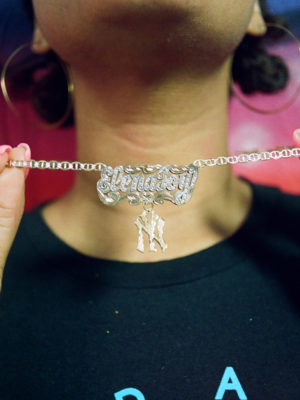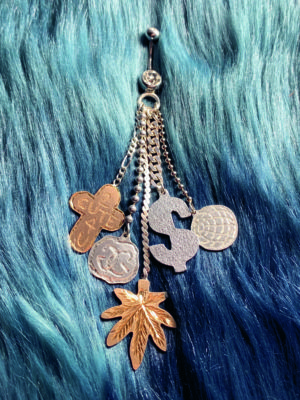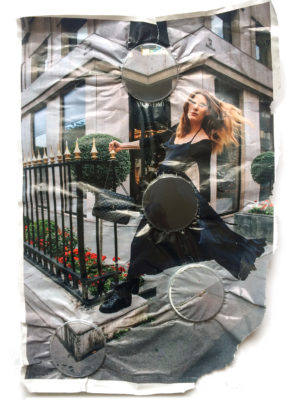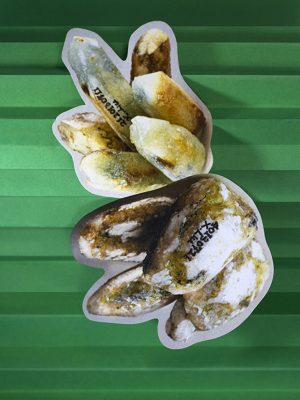This is your Broadway/Broad Street/Main Street jewelry shop on steroids and it is so beautiful. Despite other shops’ designer labels and multi-carat diamonds, no store further uptown ever had this effect on me. I want to stay here forever, as myself browsing or as a fly on the wall peeping my favorite artists dropping stacks. But instead I’m just here for a minute, looking to consider the line between jewelry that’s authentically street and of the people, and jewelry that, through exposure, enters the public consciousness and more widespread popularity.
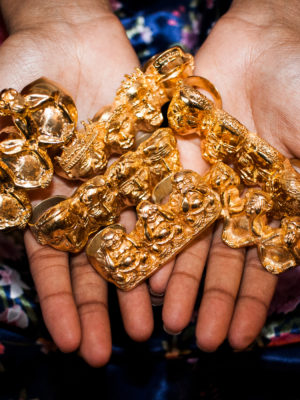
High fashion has continuously been influenced by the streets, drawing on youth and POC culture and style, and marketing it in a way that makes it appealing to broader markets and more affluent consumers. We can look at Harlem’s iconic designer, “hip-hop fashion’s godfather” Dapper Dan, who brought bootlegged designer monogrammed patterns to custom tailored uptown street style in the 1980s. He has more recently been mimicked by, and then upon public outcry linked up with, the monolithic fashion house Gucci, who once sued him for copyright infringement. The tastes and styles of marginalized groups—immigrants, people of color, the working class—have historically been rejected as tacky or lowbrow, often invalidated by those with more power. With visibility, and when prominent tastemakers decide it’s “cool,” these styles are coopted, monetized, and then legitimized for “mainstream” (read: white, middle-/upper-middle class) consumption.
___STEADY_PAYWALL___.
This is definitely the case for the American nameplate necklace. Nameplates have historically been a vehicle for marginalized people to claim our identities and selfhood. Wearing our sometimes-unconventional/non-white/non-American names proudly on our chests serves as a form of resistance to the status quo. Seeking to bring the beloved “street-style” jewelry phenomenon into archivable, academic study, PhD-candidate Marcel Rosa-Salas and writer and editor Isabel Flower have embarked on a project called #DocumentingTheNameplate, theorizing through writing and capturing images of real people and the jewelry they wear. The project is based both on IG hashtags that allow anyone to contribute, and events where people can attend, have a drink, and be photographed.
Marcel and Isabel have noted the rise in popularity of nameplates since Sex and the City’s Carrie Bradshaw donned a necklace with her name on it. The show’s stylist, Patricia Fields, says when she saw “kids in my neighborhood” (read: working-class youth of color from the hood) wearing nameplate necklaces, she was inspired to add a simple understated version to the show’s repertoire—a plain Jane, single-plated, unadorned gold script bearing the name Carrie. Kicking off the trend, through Carrie, Patricia Fields acted as a vessel to bring a style created by marginalized people to the mainstream, “legitimizing” it for a broader audience’s consumption. The way Marcel and Isabel reflect on nameplates functions as a sort of microcosm. They’ve written about the “fraught intersection of taste, class, gender, and race that resides in the nameplate as an object, and that has shaped the perception and adoption of nameplate jewelry in the United States.” The concept of taste is rooted in social hierarchy and political histories.
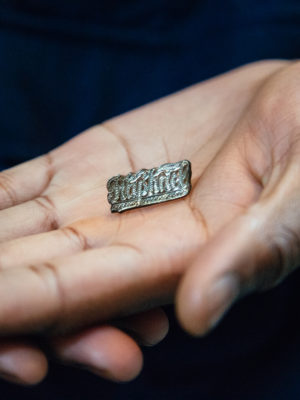
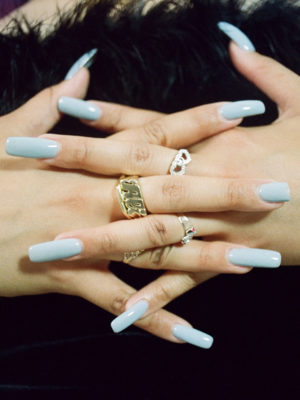
Isabel recalls people giving her backhanded compliments about her nameplate jewelry throughout the years—“It’s so cool that you’re wearing that, it’s so tacky and ironic!”—but this is the style she came up around and her love for the nameplate is genuine. She notes that these adornments are timeless and symbolic, means of claiming one’s selfhood. Yet, there is an unspoken class and race implication inherent in some particular nameplate styles (double-plated, diamond cuts, bi-metal, decorated with hearts and underlined, xoxo chains) and Isabel and Marcel wonder why this is. Who is the purveyor of taste? To whitewash and reduce these nuances, these aspects, these very real people who have made the nameplate into what it is, is to erase the histories of the rich cultural landscape of NYC.
While the culture might get lost in trends and fashion, there are still a variety of jewelers and creatives in NYC exploring their identities and upbringings, celebrating their personal histories and their city, and paying homage to those who came before them. One such jewelry designer, Johnny Nelson, was raised in Brooklyn and influenced by the punk and hip-hop scenes—street subcultures he found himself in and around. Johnny notes the role of artists like Puff Daddy and LL Cool J (both native New Yorkers) and how they sparked his desire to wear earrings, recalling that he was finally allowed to have his ears pierced as a reward for a good report card in grade school. Within a year, he finally copped nameplate earrings that read Jay—double-plated, diamond cuts, with the Y extending into an obligatory line underlining the name.
Johnny eventually started making jewelry that he says he designs with himself in mind, using iconography with nods to history tucked in, like a ring with the Black Panthers logo. Everyday he rocks his large four-finger Mount-Rushmore-inspired rings—one set with four iconic rappers, the other with four figures from the civil rights movement. He tells me that recently he was in the street and a young kid came up to him and started pointing to each of the figures on his rings, one by one, asking, “Who’s this?” Johnny notes that his works function not only as stylish conversation starters, but also as tools to encourage learning—he imagines the inquisitive kid may have gone home and been inspired to learn more about some of these luminaries and their roles within powerful POC-led movements. Using such symbols in his bold designs, Johnny’s jewelry allows wearers to claim and display their identities unapologetically.
Similarly influenced by her own heritage, Mellany Sanchez celebrates her upbringing as a Puerto Rican in New York City. She was first noticed when she began curating an Instagram page and, having worked her way up as a stylist, at the age of 26 she is now an image director for Drake. Scrolling through her IG, we can see flicks of sneakers and athletic wear doused with gold hoop earrings, chains, and nameplates. Through these pictures, many that could just as easily be from today as they might be nineties vintage, we can see her love for the city and the style it’s birthed.
“I struggled with worthiness and acceptance, but I got a hold of it in sixth grade when I realized I couldn’t be like those girls [at school in Staten Island] and fully accepted the Nike-wearing, hoop-loving girl I was.”
Mellany recently released a zine called “Puerto Rico Mi Encanta,” which celebrates her history, from her mother who came to New York from the US territory, to her own life as a born-and-raised New Yorker. In a tweet, Mellany explains, “I worked on a visual homage of the intimate markers of Latina identity in New York and the shared experiences of the female Nuyorican community.” Many pages are filled with family photos, there are other pages that pay homage to Latina business owners and public officials, and one spread is a catalog of nameplate pendants. The aesthetics of hair, nails, and, of course, jewelry all play a major role for Mellany, acting as visual markers of where she came from. The zine is as much a love letter to the real New York, the old New York, the diverse, immigrant New York, as it is an exploration and celebration of identity.
Then we have Nic de la Paz, the creator behind the jewelry line Botánica, who moved around between each one of the NYC boroughs growing up, and calls herself “a bit of a boro-ologist.” Remembering how difficult it was to adjust to an early move from Brooklyn to a more suburban borough, she tells me, “I struggled with worthiness and acceptance, but I got a hold of it in sixth grade when I realized I couldn’t be like those girls [at school in Staten Island] and fully accepted the Nike-wearing, hoop-loving girl I was.” Today she is unapologetic about her cultural identity, and invites others to be the same by donning her drip.
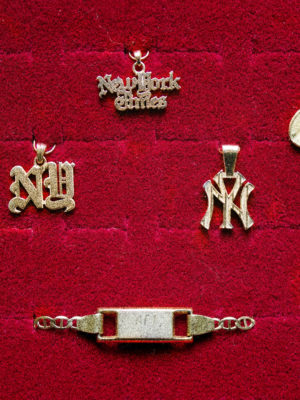
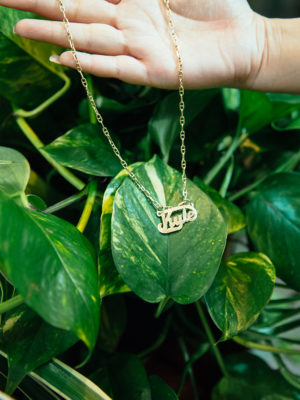
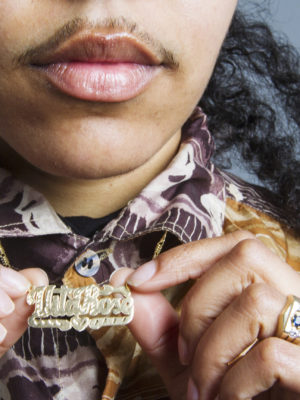
She recalls her earliest jewelry memories being of the pieces her father had bought back in Puerto Rico in the seventies and eighties, which included “crosses, chains, seventies-style single-plated male nameplates with insane diamond cuts. His collection made me obsessed with the art of diamond cuts.” Like the jewelry of her father, many of the pieces in her collections are gold and adorned with engraved diamond cuts that catch light and make these pieces really shine. This is especially true of her recent New York collection, where Nic draws on branding from authentically NYC-centric iconography: the Yankees, athletic wear logos like Champion and Nike, the classic Air Force 1 laces tag, and the MTA’s old-school subway token.
I asked Nic a bit more about nameplates and her experiences with them. She’s had her own nameplate for what feels like all her life and wears it everywhere. She explains that to her, a name is everything, and wearing it on your chest is a celebration of who you are. She tells me, “I’ve had women approach me about my nameplate and say, ‘Hey, I love your necklace, it’s like Carrie Bradshaw’s in Sex and the City,’ and I know this is meant to be a compliment. I’d smile and say, ‘This nameplate was part of my childhood looong before SATC.’ The other side of that is that it’s made [nameplates] more ‘acceptable,’ for lack of a better term, in the fashion world.”
I stan these people who are out here doing it for the culture and who, in the face of trends and fashion that can erase histories in favor of something boring and sterilized, refuse to allow their various identities and upbringings and heritages to be swept under the rug. Like Nic says, “Nameplates will always be a part of my culture and a representation of the city I grew up in.” She adds, “Growing up, your nameplate wasn’t shit if it wasn’t double-plated with the diamond look on the first initial and the underline.” Yerrrr! Sorry, Carrie.
Ashley Khirea Wahba is an Egyptian-American artist and jeweller from the NYC area. Her current studio work explores notions of identity, ownership, agency, and reclamation, often in direct response to memetics. She’s interested in the role of reference culture and how layers of signaling manifest as a language that traverses URL and IRL.
@ashley_khirea_wahba_jewels
This article was first published in the #6 Current Obsession Paper for New York City Jewelry Week
